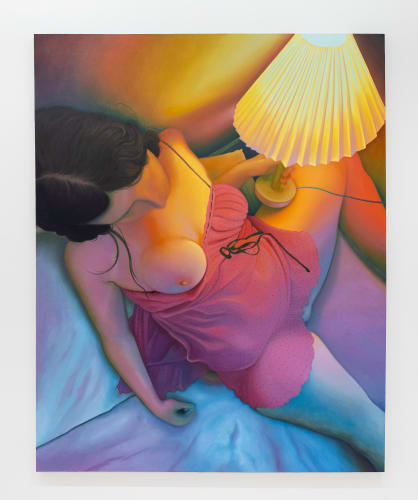DIMIN is proud to present Sitting Ducks, a provocative showcase of the newest work from Brooklyn-based artist Elena Redmond. Through her distinctive approach to portraiture, Redmond continues a voyeuristic, jewel-toned journey through her personal relationship with privacy, vulnerability and power. The work in Sitting Ducks further tests the tensions between compliance and rebellion, visibility and exposure, power and objectification — all through the lens of the female form, refracted across history, literature, and the sharp light of a New York apartment window. Drawing from the idiom, Sitting Ducks investigates what it means to be on display, a vulnerable target waiting in the shade. In this work, figures are poised not simply as subjects, but as sites of projection and psychological negotiation. With references ranging from Mannerist painting to Surrealism, Redmond samples art history in quiet commentary on how femininity is historically performed, perceived, and painted.
The figures in Sitting Ducks are not muses; they are decoys, mirrors, symbols. Their bodies and surroundings echo the compositional stiffness of Vermeer’s doorways, the isolation of Hopper’s shadows, and the cool eroticism of Currin and Yuskavage. Threaded through the works are nods to Lili Anolik’s book Didion and Babitz, in which “rebellion masquerades as compliance”. Anolik offers that both writers purposefully utilized their public persona, style, and acts of rebellion as strategic performance, allowing them to critique the very structures that they appeared to comply with. Didion and Babitz are in stark contrast to one another, one dry, stiff, cocksure and the other brazen, fiery, wet— mimicking the opposing balance of the unseen masculine and overt feminine Redmond alludes to in these paintings. She likewise draws inspiration from Maggie Nelson’s The Art of Cruelty, particularly the reduction of a human being into a passive thing—a body without a voice, used or gazed upon without agency. Nelson analyzes how some artists willingly undergo this transformation in their work, perhaps to critique it, but also how such gestures can veer into self-objectification or even submission to violence. These influences animate the canvases with an eerie stillness: window-framed interiors and partially veiled figures, eyes averted, faces obscured, painted in a monochrome palette that refuses melodrama but smolders with implication.
In homage to her literary influences, Redmond anchors the exhibition on her largest work to date, Age of Compliance. This piece crystallizes the diverse influences from art history that Redmond draws upon. The conspicuous exposure of a single breast draws from the sleek exaggeration of the Mannerist depiction of the female form. Earlier still, the piece is a direct reference to Jean Fouquet’s early Renaissance diptych Virgin and Child Surrounded by Angels (c. 1450). Its stylized anatomy, unnatural color palette, and hieratic composition ripple throughout the paintings in Sitting Ducks. Likely modeled after Agnès Sorel, the mistress of King Charles VII, Fouquet’s ‘Virgin’ adds a layer of courtly politics and idealized femininity of the time to the religious iconography.
Expanding on Redmond’s interest in performative femininity, the exhibition progresses to reveal architectural reference points—most notably, the window. Drawing on Vermeer’s luminescent windowed portraits, Redmond’s idiomatic Dogs in the Window depicts two nude figures on display as golden light filters through sheer curtains. While the solitary action of Window Performance harkens the cool color of Edvard Munch’s Girl in the Window, and the pensive lady peering out onto the New York skyline in Hopper’s Morning Sun. Together these works situate the window not merely as a structural element, but as a symbolic threshold between interiority and exposure, contemplation and display.
Sitting Ducks considers how intimacy can be aestheticized, how rebellion can be asserted through modesty, how compliance itself becomes a performance. The male presence is felt — not seen — in the rigidity of the pose, the architecture of the room, the temperature of the paint. Meanwhile, Redmond makes the conscious choice to obfuscate the figures’ identities, their faces abstracted into the composition, shielded behind the thinnest veil of representation. Her paintings hover between seduction and confrontation, seclusion and intrusion. “Like a pigeon perched in a city window,” the artist explains, “seemingly soft, vulnerable—but watching everything. And watching you.”
Elena Redmond (b. 1998, Pittsburgh, PA) lives and works in New York City. Sitting Ducks is Redmond's first solo exhibition at DIMIN. Redmond exhibited in DIMIN’s three-person exhibition Unfeigned Mysteries (2024) which was featured in A Women’s Thing. She has mounted solo exhibitions with Long Story Short, Los Angeles (2022) and Tchotchke Gallery, New York (2022). Redmond has participated in group shows at Moosey Gallery, London; Orlando Museum of Art, Orlando; Blouin Division and Arsenal Contemporary, Montreal; Hashimoto Contemporary, Los Angeles; Andrea Festa Fine Art, Rome; and Eve Leibe Gallery, London. Redmond holds a BFA from Rhode Island School of Design, Providence, RI.
DIMIN is located in Tribeca at 406 Broadway, Fl. 2, New York, NY. DIMIN is open Tuesday to Friday, 10am to 6pm; and Saturday, 11am to 6pm. For all inquiries, please contact gallery@dimin.nyc.

